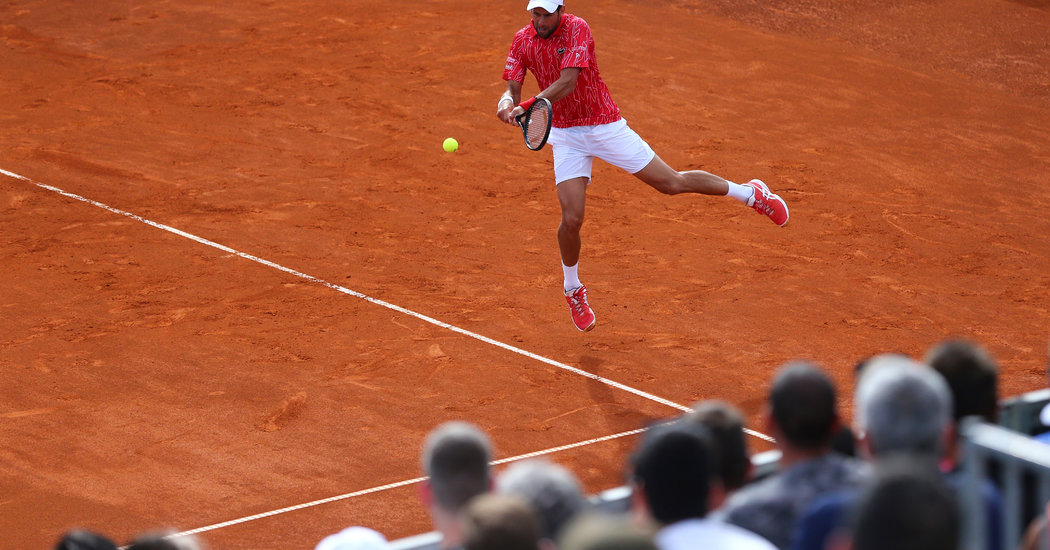
Novak Djokovic Tests Positive for the Coronavirus
Novak Djokovic, the world’s top-ranked male tennis player, apologized on Tuesday as he announced that he and his wife, Jelena, had tested positive for the coronavirus. His mea culpa came after days of growing criticism over a tournament he organized, after which other players and coaches were also found to be infected.
“I am so deeply sorry our tournament has caused harm,” Djokovic said on social media.
The exhibition event, called the Adria Tour, was supposed to bring some of the world’s best players to Balkan nations, including Serbia, where Djokovic is from, and provide some income for the participants and some welcome entertainment to tennis fans who haven’t seen professional games since March.
Social distancing was not enforced in the stands during the series, and face masks were a rare sight. Players mingled freely, exchanging hugs and handshakes, playing pickup soccer and basketball, and even dancing the limbo one night in Belgrade, Serbia.
At the tournament, players posed for photographs with workers, tournament officials and spectators. No systematic coronavirus testing was required of the participants before the event began, according to the organizers. Some Croatian tennis officials are calling for the resignation of Nikolina Babic, president of the Croatian Tennis Federation.
Besides the Djokovics, two coaches and at least three prominent players tested positive for the virus: Grigor Dimitrov, Borna Coric and Viktor Troicki, a Serb whose wife, Aleksandra, also tested positive. That prompted fears among the authorities in Croatia and Serbia that the athletes might have started a cluster of infections.
In Zadar, a small coastal town in Croatia that had no confirmed infections until it hosted a leg of the competition, the authorities were left scrambling to trace and test people who might have come in contact with Dimitrov, a Bulgarian who said on Sunday after returning to his home base in Monaco that he had tested positive.
“When we saw the crowds, everyone was surprised to see an event of that size come back so soon,” said Bob Bryan, the veteran American doubles champion who watched the action from his home in Florida. “I guess the cases were low in Croatia, and they thought they could. It’s a harsh reminder that there is still a pandemic going on and everyone has to behave responsibly.”
Goran Ivanisevic, a former Wimbledon champion from Croatia who now coaches Djokovic, was the director of the event in Zadar. Ivanisevic, who said he had tested negative for the coronavirus, said it was unclear where and when Dimitrov contracted it. Ivanisevic said Dimitrov traveled to Serbia from Los Angeles and then traveled to Bulgaria before arriving in Croatia. Ivanisevic said local health officials informed the tour organizers that there was no requirement to test players or other attendees upon arrival if they were asymptomatic.
“He came here on Wednesday and was complaining about his elbow,” Ivanisevic said by telephone, referring to Dimitrov. “The first time Grigor said he was not feeling great in general was on Friday, and on Saturday he played his first match against Coric. He didn’t look very good.”
Dimitrov withdrew from his second match on Saturday, then decided to leave the event and return to Monaco.
Ivanisevic said the coronavirus was almost impossible to understand. “I was two weeks with Marco Panichi, who is Novak’s fitness coach,” Ivanisevic said. “I was with him night and day, and he is positive, and I am negative, so how to explain that?”
Djokovic returned to Belgrade with his family after the tournament’s final on Sunday was called off.
“Everything we did in the past month, we did with a pure heart and sincere intentions,” Djokovic said in a statement announcing his positive test. “Our tournament meant to unite and share a message of solidarity and compassion throughout the region.”
He said before the event began in Belgrade this month that the tour was following guidelines from local authorities by not imposing strict restrictions on player contact and by allowing spectators to attend matches.
“We believed the tournament met all health protocols and the health of our region seemed in good condition to finally unite people for philanthropic reasons,” Djokovic said Tuesday. “We were wrong, and it was too soon. I cannot express enough how sorry I am for this and every case of infection.”
Djokovic caused a stir in April after he suggested that he would rather not be vaccinated against the coronavirus. He has said he wants to know what is best for his body, while keeping an open mind. He has spoken frequently about his belief in natural healing and ventured far outside the mainstream in a podcast last month by maintaining that “molecules in the water react to our emotions.” But he sounded ready to embrace more conventional medical methods on Tuesday, urging all those who attended the Adria Tour or who were in contact with any attendees to be tested and to practice social distancing.
Djokovic, whose primary organizational role in the tour was to recruit the players, said that his two young children — Stefan, 5, and Tara, 2 — had tested negative for the virus and that he would remain in isolation in Belgrade for the next 14 days and be retested later this week. The remainder of the tour, scheduled for Banja Luka and Sarajevo in Bosnia and Herzegovina, has been canceled.
“It’s easy to be a general after a fight,” Ivanisevic said. “Everybody is smart now, and they are attacking Novak. He tried to do a great thing, a humanitarian thing. We were locked down for three months. He organized this tour. The players came in Belgrade and we had good tennis and a good atmosphere. Everything in Serbia and everything in Croatia was done with the recommendations by the government.”
Three other leading players who took part in the tour — Marin Cilic, Alexander Zverev and Andrey Rublev — announced on Monday that they had tested negative for the virus but would also self-isolate for two weeks. Dominic Thiem, the Austrian ranked No. 3, who won the Belgrade leg of the tour, has since played in another exhibition event in France. He has tested negative three times for the virus. It is unclear whether he, too, will be required to self-isolate.
Djokovic, 33, is not only the top player in the world, he is also president of the ATP Player Council, which has been actively involved in planning for the return of the regular men’s tour. The tour has been shut down since March because of the pandemic and is now scheduled to resume in mid-August at the earliest. The plan is to do so without spectators and with strict testing and health protocols in place.
Several players have criticized Djokovic’s decision to organize the Adria Tour without any such measures, arguing that it not only risked public health, but sent the wrong message to the wider world. “Apparently there’s a pandemic,” Andy Roddick, a former No. 1 from the United States, wrote on Twitter.
“A horror show,” Bruno Soares, a Brazilian doubles star who is also a member of the player council, said in an interview with GloboEsporte. “With the situation in the world, even if you are at the North Pole, you don’t go out and party and post the photos on Instagram.”
Even Ivanisevic conceded that the limbo dance, in which he took part, might have been over the top. “OK, maybe you didn’t need this,” he said. “But they are all individuals. Nobody forced anybody to come into that club. Nobody forced anybody to dance. Nobody can tell you go on the stage, take your shirt off and dance. And how do you know anyone even got infected at that party?”
What is undeniable is that the party in Zadar is now over, and that the rest of the tennis world has a cautionary tale to consider as it prepares for its official return.
“This situation is exactly why we have created a comprehensive health and medical plan with the input of our medical advisory group, as well as other experts, that was approved by New York State,” the United States Tennis Association said in a statement on Tuesday about this year’s United States Open.
Matthew Futterman and Joseph Orovic contributed reporting.








